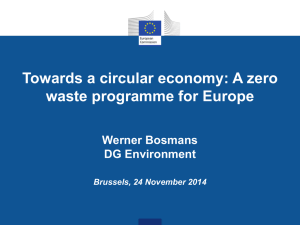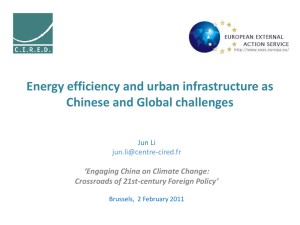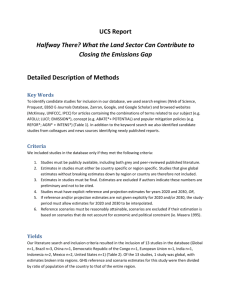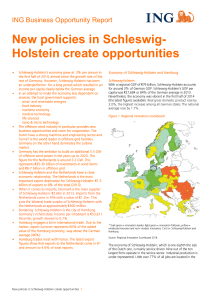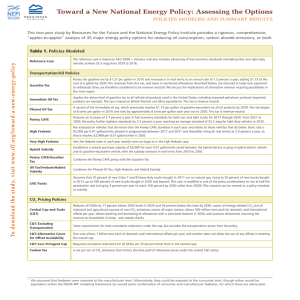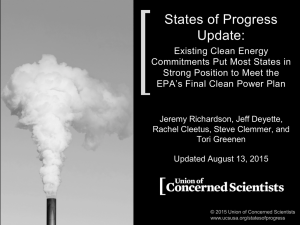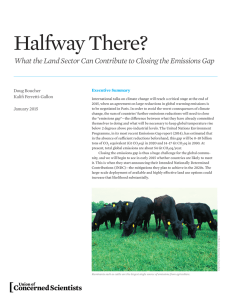Boucher-Presentation.. - Union of Concerned Scientists
advertisement
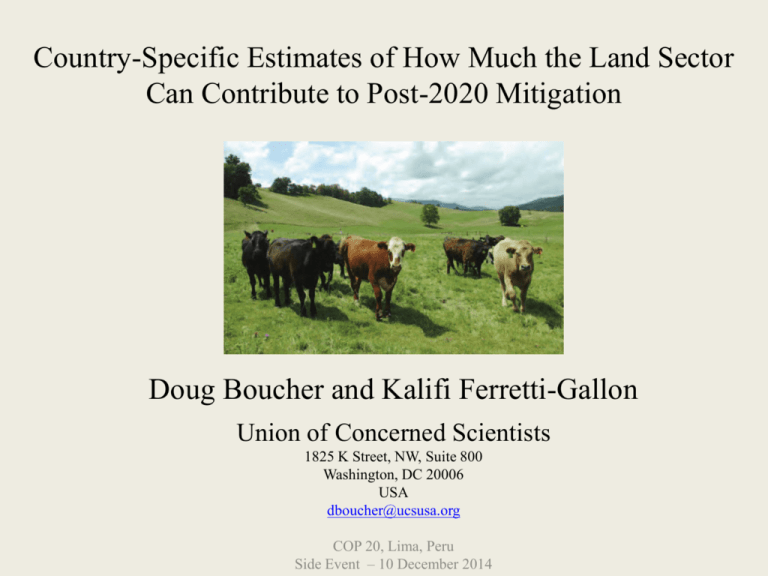
Country-Specific Estimates of How Much the Land Sector Can Contribute to Post-2020 Mitigation Doug Boucher and Kalifi Ferretti-Gallon Union of Concerned Scientists 1825 K Street, NW, Suite 800 Washington, DC 20006 USA dboucher@ucsusa.org COP 20, Lima, Peru Side Event – 10 December 2014 What I’ll be presenting today • Country-specific estimates of mitigation potential – for the post-2020 period – from the land sector (AFOLU – Agriculture, Forestry and Other Land Use) – for 8 major emitters (US, Indonesia, China, India, Brazil, European Union, Mexico and the Democratic Republic of the Congo) – Whose land-sector emissions make up 57% of the global total • Comparison of the total for these eight to the UNEP emissions gap estimates (2020, 2030) The global estimates – IPCC 2014 Estimates of global mitigation potential range from less than 1 to more than 13 Gt CO2eq, depending on carbon price and which sub-sectors and kinds of approaches (e.g. supply vs. demandside) were included. Few estimates are country-specific. Source: IPCC AR5 WG3, Figure 11.14 The Emissions Gap (UNEP 2014) Shows the difference between what countries have already pledged to do, and what is necessary to achieve the 2 degree goal Estimated at: 8 to 10 Gt CO2eq for 2020 14 to 17 Gt CO2eq for 2030 Our Methods (in brief) We reviewed the literature (both journal and “gray”) looking for country-specific estimates of mitigation potential in AFOLU Subsectors include: Reducing deforestation and forest degradation Reducing direct emissions from agriculture Reforestation and restoration (sequestration) Approaches include both supply-side (production) and demandside (e.g. reduced food waste, changing diet trends) We assembled a database of the estimates and used it to calculate country totals, their medians and their ranges, for both 2020 and 2030 We then totaled the medians for the 8 major emitters and compared them to the emissions gap estimates for those years Detailed Methods and Database online at: www.ucsusa.org/halfwaythere Methods were constrained by those of the studies we found, e.g.: Years chosen for analysis – most were for 2020 and/or 2030, not 2025 Modeling approaches, BAU reference levels, assumptions about economic growth rates, population growth rates, etc. Scenarios chosen represent technical potential, or the highest carbon price examined These choices of years, BAU, etc. do not necessarily represent UCS’ policy preferences! Results (1) 1 2 3 Table 1 – Quantitative estimates of the post-2020 climate mitigation potential of AFOLU, by country and summed across all countries studied. Units are GtCO2eq/year. 4 Country Year 2020 2020 2020 2030 2030 2030 Low High Median Low High Median United States Indonesia China India Brazil European Union Mexico DRC Sum Sum as % of Gap 5 0.6 2.8 0.3 0.2 0.1 0.5 0.7 0.4 5.2 8.4 1.9 1.7 1.2 1.0 0.5 0.4 0.2 0.02 0.4 0.6 0.8 0.4 0.3 0.2 0.2 5.8 1.3 1.2 1.0 1.6 0.7 0.3 3.1 0.8 1.0 0.7 0.5 0.4 0.2 0.02 6.8 76% 2.8 11.9 6.7 44% Results (2) Post-2020 mitigation potential is lower for several countries because of what they have already done Total emissions in Brazil have already declined by 40% in the last decade Source: Analysis of Tasso Acevedo, using data from SEEG/Observatorio do Clima Uncertainty and Comparability The number of studies found with usable countryspecific data was very small (n = 13), so small differences (few tenths of a Gt CO2eq) between countries and time periods should not be considered significant There is undoubtedly some double-counting between the mitigation potential estimates and the emissions gap calculations, particular for Brazil and Indonesia in 2020. Thus, a conservative interpretation of the potential as a percent of the gap, is that it’s about 50% for both 2020 and 2030 Thus the title, Halfway There? Conclusions The largest potential is in the United States, followed by Indonesia, China and India. Brazil and the European Union also have substantial potential to help close the emissions gap. We hope that this information will be useful in the preparation and analysis of INDCs THANK YOU! The Executive Summary of Halfway There?, with links to the detailed description of its Methods, the complete Database, and my blog post about it, are available at: www.ucsusa.org/half waythere Email: dboucher@ucsusa.org Ruminants – sheep, goats, buffalo and especially cattle – are the source of the majority of global emissions from agriculture, from: • Enteric methane • Methane in manure • N2O in manure • Feed (grains, soy, hay, etc.) • Deforestation The greenhouse gas footprint of cattle is very high – not only compared to plant foods, but also to other sources of meat. Source: Figure 2 of W. Ripple et al. 2014. Nature Climate Change 4: 2-5, with horizontal lines added Diets have been changing, very rapidly, throughout the world The environmental hoofprint of beef is much larger than for the animal food alternatives in the U.S. Data of Eshel et al. 2014. PNAS. www.pnas.org/cgi/doi/10.1073/pnas.1402183111 Over 75% of global agricultural land is used to produce livestock Beef production uses about 60% of global agricultural land Beef produces less than 5% of the world’s protein and less than 2% of its calories Data from: Figure 1 of P. Smith et al. 2013. Global Change Biology 19: 2285–2302. Based on original analyses by F. Kraussman et al. 2008. Ecological Economics 65: 471487
